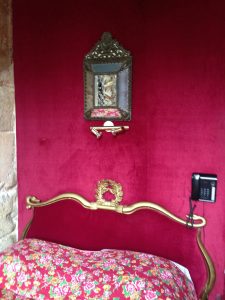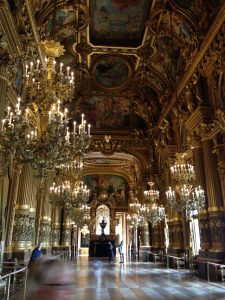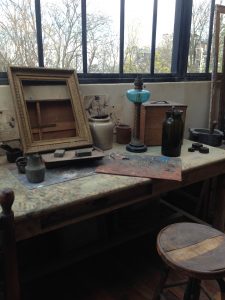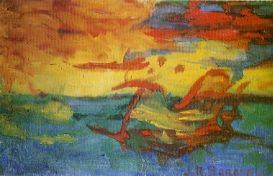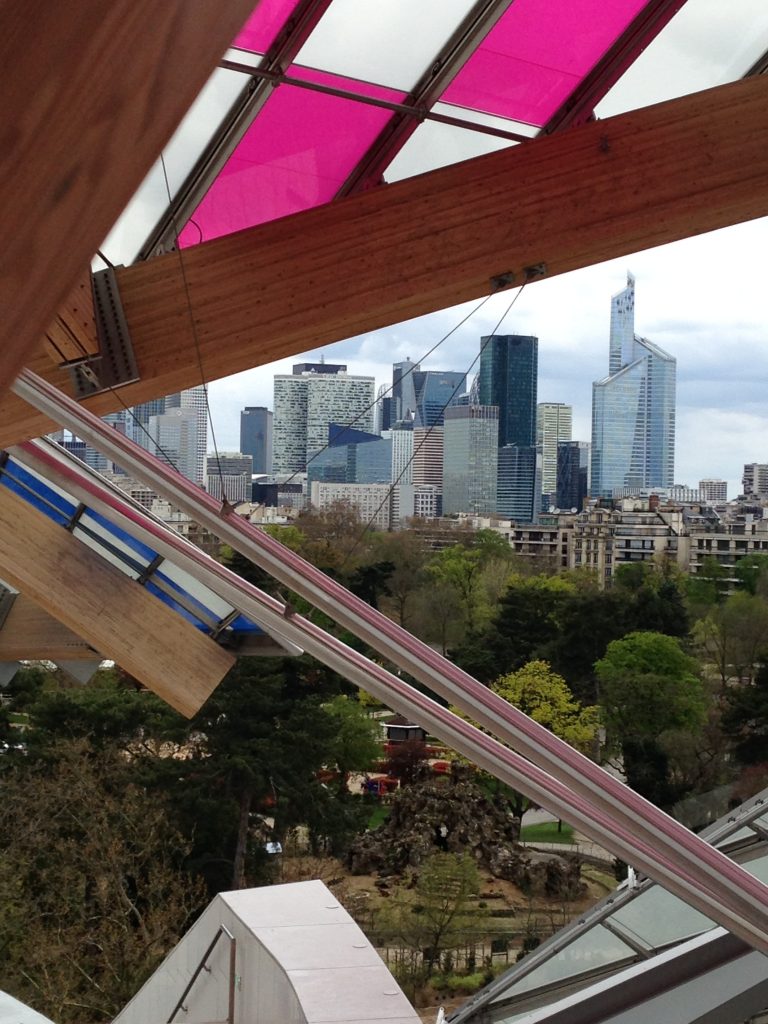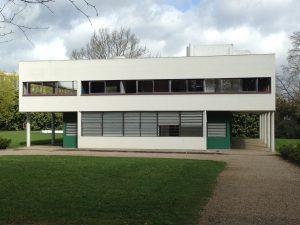I have a very special blog posting for you! During the Easter vacation, a few weeks ago, Kasia Murawska Muthesius and Stefan Muthesius took a number of Birkbeck History of Art students, from a range of programmes, to Paris, for the annual departmental study trip. This trip takes place between the Spring and Summer terms every year, and is a wonderful opportunity to visit an important city, and study works of art and architecture in situ, in the company of a couple of experienced tutors. We alternate cities particularly rich in Renaissance and Modern art – and, as last year saw Joanne Anderson and Zuleika Murat’s memorable visit to Florence, it was the turn of the nineteenth and twentieth centuries in 2016….
One of the students who went on this year’s trip to Paris very kindly agreed to write a report of the visit – even though she’s only just emerged from sitting her exams! I hand you over to Kathryn Hallam-Howard, currently on the BA History of Art programme, for the rest of this posting.
Kathryn Hallam-Howard on the Birkbeck History of Art Study Trip to Paris, 11-15 April 2016
“A wide cross-section of students from the History of Art department participated in this year’s field trip to Paris, each with their own aspirations for the week. My own hope was that I would see Paris, a city I have visited many times, through fresh eyes. Arriving at the tackily named Hotel Esmeralda – yes, you’ve guessed it – in the shadow of the magnificent Notre Dame, I was immediately shown to a room that can only be described as a boudoir. I had been warned to expect quirky, but had not quite expected to be greeted by a bed adorned with slithering golden snakes and a golden laurel wreath. No tea maker, no TV, no hairdryer – a real nineteenth-century garret to set the tone.
A quick stroll through the Tuileries Gardens brought me to the imposing and massive presence of l’Èglise Madeleine, where I met up with my fellow students and our tutors, Kasia Murawska Muthesius and Stefan Muthesius. Stefan then led us around this magnificent Neo-Classical church, which embodied Napoleon’s vision to re-create an ancient classical temple to honour his army. Dodging rain showers, as we wandered through the streets of Paris, we savoured the architecture of the Place Vendôme, before a late afternoon visit to the Louvre. There we had the chance to see some great Academy paintings at close quarters. Géricault’s The Raft of the Medusa (1819-19), Delacroix’s Liberty Leading the People (1830) and David’s The Coronation of Napoleon (1807), to name but a few.
Tuesday began at the Musée d’Orsay, where fellow students, David Daly, Julija Svetlova and Sheila Robinson treated us to three excellent presentations. David chose a series of five paintings by Claude Monet of La Cathédrale de Rouen (1892-4). To see these five paintings hung adjacent to each other, accompanied by David’s explanation about how Monet set about capturing the light and ambience, was very special. Julija introduced us to a painter unknown to most of us, Gustave Caillebotte. Her presentation on his atmospheric work, The Floor Scrapers (1875), revealed why her infectious enthusiasm for this artist was justified.
Photo: Alison Press
Sheila’s choice was a beautiful and vibrant piece by Vincent van Gogh, L’église d’Auvers-sur-Oise (1890).
A quick lunch at the Café des Deux Maggots, favourite haunt of Simone de Beauvoir and Jean-Paul Sartre. Pat Wadsworth entered into the spirit of the occasion and became our modern day Simone – a moment brilliantly captured by Frances Snelling.
No time to linger, but onwards to the Musée Rodin. The building was formerly the Hôtel Biron and was home to several great artists. Amongst its tenants were the writer, Jean Cocteau, the artist Henri Matisse, the dancer, Isadora Duncan and the sculptress, Clara Westhoff, the future wife of Rainer Maria Rilke. From 1911 onwards, Rodin occupied the whole building and it now houses over three hundred of his works, including The Gates of Hell (1880-90), The Kiss (1882) and The Thinker (1903). It was particularly interesting to see many of his partially completed sculptures, which gave great insight into his artistic process. The day ended brilliantly with a visit to the Petit Palais, built for the 1900 Universal Exhibition. There we saw an interesting collection of works and some opulent murals, which glorified the City of Paris and celebrated the benefits of art.
Wednesday arrived and we were off to the Opera Garnier. This beautifully ornate building is regarded as one of the most recognisable symbols of Paris. It was the setting for Gaston Leroux’s novel, The Phantom of the Opera, on which the West End musical is based. The interior is a maze of sumptuous internal spaces, leading to the Grand Staircase and the Grand Foyer, where Parisian society paraded in its finery and still does so today.
A brisk walk took us through several wonderfully ornate Art Nouveau arcades to the Museé of Gustave Moreau. Located in his former house, it proved to be a treasure trove of his works. Moreau was a Symbolist, whose main emphasis was the illustration of biblical and mythological figures. He had a reputation for eccentricity and this was evident in his work. It is unusual to say the least. Our minds whirring with the most bizarre images, we continued onwards to savour the unique atmosphere of Montmartre. The Église Saint-Jean-de-Montmartre, which lies at the foot of the hill, was one of the first churches to be made of reinforced concrete. Its brick and tile decoration and its stained glass windows all reflect the best qualities of Art Nouveau design.
A short walk up the hill and we passed a rather innocuous looking front door in a building to our left. Kasia gathered us together and informed us that the door led to the atelier where Picasso painted one of his most famous works, Les Demoiselles d’Avignon (1907). Looking at the ordinariness of the building and the narrowness of the front door, it was amazing to imagine Picasso struggling to deliver it to its first exhibition.
Our next stop was certainly one of the most charming museums in Paris, the Museé Montmartre. It lies tucked away in a little side street in the oldest building in Montmartre. During its heyday, it was the home of Auguste Renoir and its peaceful gardens are named after him. Suzanne Valadon had her studio here.
Valadon started life as a circus trapeze artist, but a fall led to her posing as a model for Renoir and Degas. The story goes that nine months after posing for them, she gave birth to a son. She took the boy to Renoir, who declared that the baby could not be his, “the colour was all wrong”. Degas maintained the child could not be his, “the line was all wrong”. Valadon then retired to a nearby café, where she poured out her troubles to the Spanish artist, Miguel Utrilllo. Utrillo told her to give the boy his name, since he would be proud to put his name to a work by Renoir or Degas. That baby grew up to be the artist Maurice Utrillo, famous for his many street scenes of Montmartre.
A short stroll brought us to the Café au Lapin Agile, which, under the tenancy of a local poet, Frédéric Gérard, became a magnet for artists and intellectuals. Frédé’s constant companion was a donkey, Lolo, and Lolo was the chief protagonist in an infamous art hoax, which took place in 1910. Roland Dorgelès was a writer and vociferous critic of all forms of new art. He attached a paintbrush to Lolo’s tail and held various vegetables in front of his nose, causing the little donkey to swish his tail with excitement.
 The resulting canvas, named “Sunset Over the Adriatic” by the fictitious Genoese painter Joachim Raphaël Boronali, was exhibited at the Salon des Indépendants, where it earned high praise and was eventually sold for 400 francs.
The resulting canvas, named “Sunset Over the Adriatic” by the fictitious Genoese painter Joachim Raphaël Boronali, was exhibited at the Salon des Indépendants, where it earned high praise and was eventually sold for 400 francs.
This artwork was the first of the new “Excessivism Movement”, wrote Dorgelès, for a credulous Salon. The trick was then revealed amidst much hilarity and embarrassment, and Lolo’s place in history was assured.
On Thursday morning, we found ourselves at the Centre Georges Pompidou, where Stefan explained the intricacies of Richard Rogers’s and Renzo Piano’s radical architecture, followed by a tour around some key paintings, led by Kasia. Sitting next to this wonderful gallery was the Atelier Brancusi. Constantin Brancusi was a Romanian sculptor, who lived and worked in Paris. Upon his death, he left his entire body of work to the French State and many items are housed in this replica of his studio, which has been faithfully re-created by Renzo Piano. The afternoon then brought us to the extremely modern Fondation Louis Vuitton, a new private art space, housed in a building designed by Frank Gehry.
Friday appeared far too soon, and our last day began at the Place du Dublin, scene of Paris Street: Rainy Day (1877) by Gustave Caillebotte. It was remarkable how little the architecture had changed. From there, we moved onwards and upwards to our final destination, Le Corbusier’s Villa Savoye at Poissy. This marvel of twentieth-century design was fascinating and a fitting place to conclude our trip.
All too soon it was over. It was great to meet students from other courses and from such diverse backgrounds. Huddles of Birkbeck art historians, pooling their collective knowledge, became a common sight on the streets of Paris. A huge vote of thanks must go to Kasia and Stefan, who put so much effort into making the field trip so memorable. Their enthusiasm and energy made the whole experience fabulous!”


